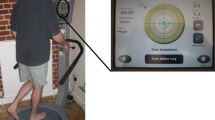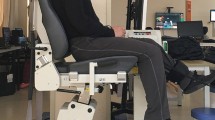Abstract
The purpose of this study was to demonstrate loss of proprioception with posterior cruciate ligament (PCL) deficiency. Eight patients with isolated PCL-deficient knees were examined to determine whether or not the proprioceptive function of the knee joint was affected or impaired by the previous tear of the PCL. The patients were examined for perception of passive movement of the knee joint using a motorized apparatus which extended or flexed the patient's knee at a rate of 0.5 deg/s in a randomized sequence. The patient's normal contralateral knee was used as a control. This study demonstrated a significant difference in proprioception in the patient's PCL-deficient knee. All eight PCL-deficient knees clearly demonstrated slower perception of passive movement when compared with the contralateral normal knee. Injuries to the PCL resulting in impaired proprioception may play a role in knee instability, further damage and ultimately the degenerative changes frequently seen in the longterm follow-up of PCL-deficient knees.
Similar content being viewed by others
References
Andrews JR, Edwards JC, Satterwhite YE (1994) Isolated posterior cruciate ligament injuries: history, mechanism of injury, physical findings, and ancillary tests. Clin Sports Med 13:519–530
Claney WG, Shelbourne KD, Zoellner GB, Keene JS, Reider B, Rosenberg TD (1993) Treatment of knee joint instability secondary to rupture of the posterior cruciate ligament. J. Bone Joint Surg [Am] 65:310–322
Covey DC (1993) Current concepts review injuries of the posterior cruciate ligament. J Bone Joint Surg [Am] 75: 1376–1386
Covey DC, Sapega AA (1994) Anatomy and function of the posterior cruciate ligament. Clin Sports Med 13: 509–518
Daniel DM, Stone ML, Barnett P, Sachs R (1988) Use of the quadriceps active test to diagnose posterior cruciate-ligament disruption and measure posterior laxity of the knee. J Bone Joint Surg [Am] 70:386–391
Fowler PJ, Messieh SS (1982) Isolated posterior cruciate ligament injuries in athletes. Am J Sports Med 15:553–557
Froese WG, Fowler PJ (1994) Reconstruction of the posterior cruciate ligament with autograft hamstring tendons and the Kennedy ligament augmentation device. Clin Sports Med 13:571–580
Geissler WB, Whipple TL (1993) Intraarticular abnormalities in association with posterior cruciate ligament injuries. Am J Sports Med 21:846–849
Hughston JC, Bowden JA, Andrews JR, Norwood LA (1980) Acute tears of the posterior cruciate ligament. J Bone Joint Surg [Am] 62:438–450
Katonis PG, Assimakopoulos AP, Agapitos MV (1991) Mechanoreceptors in the posterior cruciate ligament. Histologic study on cadaver knees. Acta Orthop Scand 62:276–278
Keller PM, Shelbourne KD, McCarroll JR (1993) Nonoperatively treated isolated posterior cruciate ligament injuries. Am J Sports Med 21:132–136
Kennedy JC, Alexander IJ, Hayes KC (1982) Nerve supply of the human knee and its functional importance. Am J Sports Med 10:329–335
Lipscomb AB, Anderson AF, Norwig ED, Hovis WD, Brown DL (1993) Isolated posterior cruciate ligament reconstruction: long-term results. Am J Sports Med 21:490–496
Noyes FR, Mooar PA, Matthews DS, Butler DL (1983) The symptomatic anterio cruciate-deficient knee. Part 1: The long-term functional disability in athletically active individuals. J Bone Joint Surg [Am] 65:154–162
Parolie JM, Bergman JA (1986) Long-term results of nonoperative treatment of isolated posterior cruciate ligament injuries in the athlete. Am J Sports Med 14:35–38
Rubinstein RA, Shelbourne KD, McCarroll JR, VanMeter CD, Rettig AC (1994) The accuracy of the clinical examination in the setting of posterior cruciate ligament injuries. Am J Sports Med 22:550–557
Skylar MJ, Warren RF, Ortiz GJ, Schwartz E, Otis JC (1993) The effects of sectioning of the posterior cruciate ligament and the posterolateral complex on the articular contact pressures within the knee. J Bone Joint Surg [Am] 75:694–699
Trickey EL (1980) Injuries to the posterior cruciate ligament: diagnosis and treatment of early injuries and reconstruction of late instability. Clin Orthop 147:76–81
Van Dommelen BA, Fowler PJ (1989) Anatomy of the posterior cruciate ligament. A review. Am J Sports Med 17:24–29
Author information
Authors and Affiliations
Rights and permissions
About this article
Cite this article
Clark, P., MacDonald, P.B. & Sutherland, K. Analysis of proprioception in the posterior cruciate ligament-deficient knee. Knee Surg, Sports traumatol, Arthroscopy 4, 225–227 (1996). https://doi.org/10.1007/BF01567967
Received:
Accepted:
Issue Date:
DOI: https://doi.org/10.1007/BF01567967




